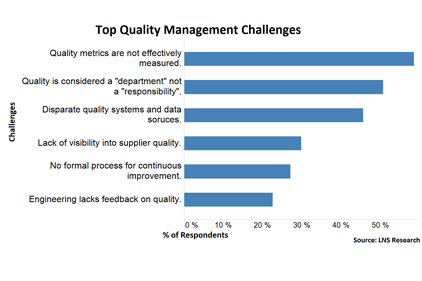
As high quality in food manufacturing has become achievable and expected, the focus on quality has shifted to managing and minimizing the cost of quality. Consequently, manufacturers offering the expected quality at the fastest rate and lowest cost of quality will succeed in the market.
One tool in the race to minimize cost of quality is closed-loop quality management strategy, in which simulations and tolerance analyses link cost factors with adjustments to achieve a balance between quality and cost. Closed-loop environments benefit from cross-functional communication and collaboration across each step of the value chain. An effective closed-loop quality management strategy allows manufacturers to identify key points quickly and easily to meet quality requirements.
However, closed-loop quality management can hit roadblocks in the optimization of people, processes and technology, according to a new post from Mike Roberts of LNS Research. The increasing complexity of products and processes has made it more difficult for manufacturers to “close the loop” on quality management. Roberts says problems tend to originate with outdated and obsolete quality control efforts in three areas: people and leadership, business process capabilities and technology architecture.
Outdated quality control efforts in people and leadership result in misaligned high-level support and culture, according to Roberts. Without an organizational commitment to top level support, decisions regarding strategies and technologies meant to improve the quality of products and processes are dispersed and made without considering their impact on the broader operation.
LNS’s research shows this problem to be widespread: More than 50 percent of executives in a 2012-13 quality management study said viewing quality as a department rather than a responsibility was their most pressing quality management challenge. Successful cost of quality requires employees outside of quality-specific functions to take ownership of their impact on the quality of products and processes.
The second common roadblock in closed-loop quality management, according to Roberts, is a lack of long-term quality vision around business processes. Large operations often suffer from a lack of standardization of solutions for the same quality process. They may vary by plant, business unit, division or geography, and the lack of cohesiveness represents a challenge for companies trying to close the quality loop. In LNS’s quality management study, 47 percent of executives said disparate quality systems and data sources were a serious concern. Roberts says executives today face a tangled web of processes and solutions that can require significant backend work to communicate a standardized set of data.
The final obstacle in closing the quality loop is disconnected technology architecture. Roberts says that despite the emergence of the Enterprise Quality Management Software category, many operations have yet to automate, standardize and centralize quality control functions via that platform. In fact, many large companies that have experienced merger and acquisition activity may have more than one enterprise application, such as ERP, MOM, PLM, CRM or SCM. Disparate enterprise applications can create a roadblock to closed-loop quality management as processes are built onto and on top of them.
Roberts urges executives considering adding to their quality management portfolio to assess current quality capabilities, culture and IT architecture for more effective closed-loop quality management. By overcoming the roadblocks mentioned here, executives will increase the likelihood of success for their operation by achieving an optimal balance between cost and quality.
For more information, visit LNS Research's website.





